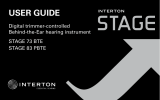
USER GUIDE - BTE
I n T E R To n s c o p e
S465-D
S465-D Open
S470-D
S470-D Open
S480-D
S665-D
S665-D Open
S670-D
S670-D Open
S680-D

2 3
Thank you for selecting an Interton hearing system. We are proud of our hearing products and are
confident you have chosen one of the best products available. Please familiarize yourself with the
information in this guide. It contains important instructions for proper use and care, technical perfor-
mance information, and other general information about your hearing system. Your hearing system
has been adjusted to your particular hearing loss. Your hearing healthcare professional will explain
these adjustments and the special features of your particular model.
Becoming Accustomed to Amplification
While purchasing a hearing system is a major step, it is only one step in a process toward more
comfortable hearing. Successfully adapting to the amplification your hearing system provides takes
time and consistent use.
You will enjoy more benefits from your Interton hearing system by taking the following actions:
• Wear the system regularly in order to get comfortable with using it.
• Begin by wearing your system for short periods of time in quiet environments.
• As you get more comfortable with the system, increase the wearing time and wear your hearing
system in multiple types of listening environments.
It may take as long as several months for your brain to get used to all the “new” sounds around you.
Following these suggestions will give your brain time to learn how to interpret amplification and
increase the benefits you get from using an Interton hearing system.
Contents
Your Hearing System 4
On/Off Function 8
Power-on Delay 9
Stand-By Mode 9
Volume Control 10
Changing Memory Programs 11
Dual Microphone System 12
Proper Placement in the Ear 13
Recognising Left and Right Instrument 17
Using the Telephone 19
Telecoil 19
Cellular Phone and Hearing Instrument
Compatibility 20
Using Assistive Listening Systems 21
Audio Input 22
Removing/Inserting the Battery 23
Low Battery Warnings 24
Maintenance and cleaning 26
Cleaning the Earmould 27
Replacing the Tube 28
Cleaning the Thin Tube and Dome 28
Earwax Management 30
When the Hearing System Is Not in Use 30
Things that Can Damage
Your Hearing System 31
Moisture 31
Temperature Extremes 31
Rough Treatment 32
Corrosive Substances 32
General Warnings 32
Solving Small Problems 34
General Precautions 38
Hearing Instrument Identification 39
Repairs 40
Technical Specifications 40
Notes 41

4 5
Scope 4/Scope 6 Mini BTE Hearing Instrument
Earhook
Program button
Plastic tube
Earmould
Battery door and
On/Off switch
Front microphone
Rear microphone cover
Scope 4/Scope 6 Mini BTE Hearing Instrument with Thin Tube
Program button
Thin tube
Mini dome
Battery door and
On/Off switch
Front microphone
Rear microphone cover

6 7
Scope 4/Scope 6 BTE Hearing Instrument
Program button
Plastic tube
Earmould
Volume toggle
Scope 4/Scope 6 BTE Hearing Instrument with Thin Tube
Program button
Thin tube
Mini dome
Volume toggle
Earhook
Battery door and
On/Off switch
Front microphone
Rear microphone cover
Battery door and
On/Off switch
Front microphone
Rear microphone cover

8 9
Scope 4/Scope 6 Power BTE (PBTE) Hearing Instrument
Program button
Earmould
Volume toggle
Battery door and
On/Off switch
On/Off Function
The door to the battery compartment serves as the On/Off
switch for your hearing instrument. When the door is fully
closed, the instrument is on. To turn the instrument off, press
the tab on the base of the instrument with your fingertip until
the battery door snaps partly open, then put your fingernail
under the nail grip and pull gently to open it completely.
Tip: To reduce battery consumption,
turn the instrument off when it is not in use.
.
switch off the instrument
1
st
Microphone sound outlet
2
nd
Microphone sound outlet
Plastic tube
Earhook

10 11
Power-on Delay
Power-on delay allows you to insert the instrument in your ear without the hearing instru-
ment squealing. It delays the switch-on time by 10 seconds after closing the battery
compartment. A beep each second is presented during this time.
Stand-By Mode
Stand-by mode reduces battery consumption since only a small amount of power is
used. When in stand-by mode, the hearing instrument will not deliver sound to the ear.
To put the instrument into stand-by mode, hold down the Memory Selector for more
than one second. You will hear a series of beeps, indicating that the instrument is now
in stand-by mode.
To return to functional mode, simply press the Memory Selector once.
Volume control – BTE and PBTE
Your instrument has a fully automatic volume control. Therefore,
it should not be necessary to control the amplification (volume)
manually.
However, the volume control toggle provides you with the ability
to adjust the amplification to your liking.
Use your index finger to adjust the volume, pushing the toggle
horizontally or upwards to increase and downwards to decrease
the volume.
During the fitting of the instrument, your hearing care practitioner will have chosen an
optimal volume setting for you. When switching the instrument on, the volume will have
this optimal setting.
• To prevent unintended usage by paediatric or physically or mentally challenged users,
the volume control must, if enabled, be configured to only provide a decrease of the
sound generator output level.
• If you prefer not to use the volume toggle your hearing care practitioner can switch
the volume control off

12 13
Changing Memory Programs
Hearing instrument memories are used to store settings optimal
in different listening situations. Your hearing healthcare professio-
nal may have programmed multiple memories into your hearing
instruments to accommodate your lifestyle needs.
For future reference, ask your hearing health professional to fill in
your memory program information on the notes page at the back
of this guide.
Whenever the hearing instrument is turned on, Memory 1 is automatically activated.Me-
mories can then be selected by pushing the Memory Selector button on the instrument.
Your hearing instrument may have up to 4 programs. Special tones will indicate which
memory has been activated. One tone will sound when Memory 1 is activated, two
tones will sound when Memory 2 is activated, etc. Memories are always activated in
sequence, for example, with three memories: 1 to 2, 2 to 3, 3 to 1.
Consult your hearing healthcare professional if the memory programs in your hearing
instruments need to be reconfigured.
Dual microphone system
If you want to listen to a person in a noisy environment, the microphones in your hearing
instrument can help you to concentrate on the speech. If the microphones are in the di-
rectional mode the background noise will be attenuated. In this mode the sounds in front
of you will be enhanced, so you can hear better the speech of the person you look at.
Your hearing care practitioner can program the device in the required modes.
Depending on your hearing instrument and the setting chosen by you and your hearing
care practioner switching to and from directional mode can be done automatically.

14 15
Proper Placement in the Ear
Inserting the Dome and BTE Instrument:
• With the battery door open (the off position), hold your hearing instrument by the
tube, right where it bends.
• Hang the instrument over the top of your ear so that the housing portion is behind
your ear and the dome is in front.
• Push the dome into your ear until it sits comfortably and the tube lies flat against
the side of your head. Note: When the dome is placed correctly, you should not see
the tube sticking out when looking directly into a mirror.
• If you have not already turned on your hearing instrument, switch it on by closing
the battery door.
If you need further help, your hearing healthcare professional will be glad to show you
how to insert your hearing instrument correctly.
Note: If your hearing instrument irritates your ear in any way and prevents you from
wearing your hearing instrument, please contact your hearing healthcare professional.
Never attempt to modify the shape of your hearing instrument yourself.

16 17
Inserting the Standard Earmould and BTE Instrument:
• With the battery door half open (Off position), put your ear-
mould between your thumb and index finger and position
its “point” in your ear canal. - Now, slide the earmould all
the way into your ear with a gentle, twisting movement.
• Place the hearing instrument behind your ear. Move the
earmould up and down and press gently to ensure it is
positioned correctly in the ear. You will feel when the ear-
mould is positioned correctly.
• Switch on your hearing aid.
Tip: Insertion of the earmould can be easier if you gently pull
your ear backward with your other hand. Opening and closing
your mouth while inserting may also be helpful.
Removal
To remove the hearing instrument from your ear, simply pull the tube outward with your
thumb and forefinger. Consult your hearing healthcare professional if you have difficulty
removing the hearing instrument.

18 19
Recognising left and right instrument
If you have two hearing instruments, they may be tuned differently. One for your left ear,
the other for your right. Do not swap them. Please pay attention to this when cleaning,
storing and inserting the instruments.
left
right
Indication
left
right
• You might want to ask your hearing care practitioner to
mark your instruments with a coloured Left and Right
indication:
Left is blue and Right is red.

20 21
Using the Telephone While Wearing your Hearing System
Close proximity to a telephone can sometimes cause hearing in-
struments to make a squealing sound, also known as feedback.
To reduce the potential for this problem, your system is equipped
with a feedback management system, which greatly reduces the
chance of feedback. Further measures to avoid feedback include
position ing the phone close to the hearing instrument, but not
directly on the instrument. If there is feedback, it may take a few
seconds for the instrument’s signal processing to adapt. This
technique may require practice.
The Telecoil Feature
Your hearing system has a built-in telecoil, and your hearing healthcare professional may
have programmed one of your listening programs to take advantage of it. When a telecoil
is activated, the hearing instrument will only detect and process sounds from coming
from the telephone.
To activate the telecoil you will need to use the memory selector to activate the appro-
priate memory.
To use the telephone while the telecoil is activated, position the telephone near, but not
directly on the instrument. You may need to re-position to find the best reception.
Cellular Phone and Hearing Instrument Compatibility
Hearing instrument performance with cellular phones may vary based on the individual
hearing system or the cell phone being used. If your hearing system and cell phone are
not compatible you may experience a buzzing or clicking noise while using the two in
conjunction. If this is the case with your current hearing system and cell phone, consult
with your hearing healthcare professional to see if there are options to improve the sound
quality
Measures you can take to prevent this situation:
• When purchasing a hearing system, be sure to test it with your existing phone to
determine compatibility.
• When shopping for a new cell phone, be sure to test it with your hearing system
before purchasing.
For additional guidance, please consult your cell phone provider.

22 23
Using Assistive Listening (Tele-Loop) Systems
Many gathering places are equipped with assistive listening (tele-loop) systems, for
example, in schools, theaters and houses of worship. To take advantage of a tele-loop
system, select the telecoil program. When the telecoil program has been selected,
you will be able to hear a clean sound signal via the tele-loop system. If the instru-
ment goes dead in the telecoil program, this may be because the loop system is not
operating.
If a school, theater or house of worship does not have a tele-loop system, try and sit
as close as possible to the front and use one of the microphone programs.
Audio input
Your hearing instrument is equipped with a direct audio input
facility. Direct audio input allows direct connection of sound
sources, a radio, television or even school equipment, to your
hearing instrument. Often, this will improve sound quality.
• The sound source is connected to your instrument with a
cable and an audio shoe.
• The instrument automatically detects the direct audio input
source. The direct audio input supports the systems for the wireless use as well.
• In this program you will hear no sounds from the microphone, therefore most
en vironmental sounds will be lost. If you wish, your hearing care practitioner can
change the setting in such a way that you hear the microphone and the direct audio
input simultaneously.
Safety regulations
External equipment, connected to the mains and to the audio input must comply with
these safety regulations: IEC-65, IEC-601 or comparable.

24 25
Removing/Inserting the Battery
Open the battery compartment completely by pressing the tab
on the base of the instrument with your fingertip until the battery
door snaps partly open, then put your fingernail under the nail grip
and pull gently to open it completely. Remove the used battery
from the battery compartment.
Tip: Hold the instrument over a table or a soft surface in case
the battery falls out.
Remove the film from a new battery and place the new battery
into the battery compartment, matching the plus (+) sign on flat
side of the battery to the plus sign in the battery compartment.
A magnifying glass and good lighting may be helpful in seeing
these small markings. Close the battery compartment tightly
but do not use force - it should close very easily. Your hearing
system should now be on.
open battery door
completely
exchange battery
Tip: Removing the battery when the instrument is not being worn will help prevent cor-
rosion of the battery contacts. Corrosion can decrease efficiency, causing excessive
battery consumption.
Note: A weak battery will cause reduced system performance.
Instrument type Battery size
Mini-BTE 312
BTE 13
PBTE 13
Low Battery Warning
Your hearing system features a Low Battery Warning function to give you notice when
your battery is getting low. The instrument will signal when the battery power de-
creases to a certain level, and will continue beeping until the instrument automatically
switches off.
Tip: It is helpful to keep spare batteries with you in case you need them.

26 27
Battery Safety
• Dispose of used batteries properly.
• Keep batteries out of reach of children or persons with diminished mental capacity.
• Keep batteries away from pets.
• Do not place batteries in your mouth. If a battery has been swallowed, consult a
physician immediately.
To prevent batteries from leaking or exploding:
• Do not expose batteries to temperature extremes.
• Do not dispose of batteries in fire.
• Do not attempt to recharge batteries which are not specifically designated re-
chargeable, or reverse a battery’s polarity.
Maintenance and cleaning
Earwax (cerumen) can accumulate in and on the earmould during use. Therefore, clean
your earmould regularly. Failure to do so can lead to an accumulation of earwax, impairing
sound quality.
Keep your hearing instrument clean and dry. Wipe the case with a soft cloth or tissue
after use to remove grease or moisture. You should avoid exposing your instrument
directly to moisture such as rain or water from the shower. If your instrument does
get wet or if it has been exposed to high humidity or perspiration, it should be left to
dry out overnight with the battery out and the battery compartment open. It is also a
good idea to put them in a sealed container together with a drying agent (dessicator)
overnight. Consult your hearing care professional as to which drying agent to use.
Storing your instrument
When you are not using your instrument, keep or transport it in the box supplied.
Leave the battery door open. Keep your instrument in a dry place, not in a bathroom or
other humid place. Alternatively, you could store the instrument in a dessicator available
from your hearing care practitioner.

28 29
Cleaning the earmould
• First, remove the tubing and earmould from the hearing in-
strument. Keep left and right instrument separated.
• Remove earwax with the cleaning brush and a soft cloth.
If needed, use a mild solution of soft soap and water or a
special cleaning solution. Ask your hearing care practitioner
for detailed instructions.
• Rinse the earmould with water.
Note: Do not use water or other liquid on the hearing instrument itself.
pull earmould
and device apart
• Dry the earmould with a cloth.
• Let the earmould dry overnight on a tissue or blow possible
water drops from tubing and earmould. A special device is
available for this from your hearing care practitioner.
• Ensure that the earmould and tubing are completely dry be-
fore attaching them to the hearing instrument. Take care with
left and right instruments, check the figures on page 17.
Replacing the tube
Ask your hearing care practitioner to replace the tubing from the instrument to the
earmould if it turns stiff or changes colour.
Cleaning the Thin tube and dome (if applicable)
The thin tube feeds the amplified sound from the hearing instrument into the ear. It
is important that the thin tube and the dome fit correctly into your ear. If the thin tube
or the dome irritate your ear in any way and prevent you from wearing your hearing
instrument, please contact your hearing care professional. You should never attempt
to modify the shape of the thin tube yourself.

30 31
The thin tube and the dome should be cleaned regularly.
Remove the thin tube from the instrument before cleaning by
unscrewing it. Use a damp cloth to clean the thin tube and
dome on the outside and use the black cleaning rod to “push”
any debris out of the sound tube. The cleaning rod should be
inserted where the thin tube attaches to the instrument and
pushed all the way through the thin tube and out through the
dome. It is not recommended to submerge or rinse the thin
tube and dome with water, as there is a risk that a water drop may become lodged in
the thin tube. If this should occur, it will prevent sound coming through the thin tube,
and may be harmful for the instrument’s electronics.
The thin tube and dome should be changed every third month or sooner if the thin tube
becomes stiff or brittle. We recommend that you have your hearing care professional
change the dome for you. If your hearing care professional instructs you to change
the domes yourself, make sure that they are securely fastened to the thin tube before
inserting them in your ear. A failure to change the domes in accordance with the in-
structions could result in injury.
Earwax Management
Hearing systems are susceptible to damage or poor performance from earwax. If
appro priate, your hearing health professional will have selected and installed an ear -
wax management system on your instruments.
You will need to discuss with your hearing healthcare professional how to use the
particular earwax management system selected. For future reference, enter this infor-
mation on the service page at the back of this guide.
Note: If the hearing system seems to have lost power because it is not loud enough and
changing the batteries does not help, the filters may be blocked and need to be changed.
When the Hearing System Is Not in Use
To protect your hearing system when it is not in use, always store it inside its carrying
case. When storing the hearing system for a prolonged period of time, remove the
battery to prevent damage from corrosion.

32 33
Things that Can Damage Your Hearing System
Keep in mind that some of your day-to-day routines require that you remove your
hearing system.
Moisture
Avoid getting moisture in the hearing system. It should not be worn in the shower,
bath, or sauna. Do not submerge the instrument in water or other liquids.
If perspiration or humidity is an issue, you may find it beneficial to use a drying kit
specially designed for hearing systems. To prevent damage, only use drying kits that
are approved by your hearing healthcare professional.
Temperature Extremes
Do not expose your hearing system to extremes of heat.
Some typical situations to avoid:
• Do not wear your hearing system when using a hair dryer.
• Do not leave your hearing system in your car or in direct sunlight.
• Do not attempt to dry your hearing system in any device other than an approved
drying kit.
Rough Treatment
Protect your hearing system from rough treatment by storing it in the provided carrying
case when it is not in use.
Corrosive Substances
• Non-Approved Cleaning Solutions - If you use cleaning products, only use those
recommended by your hearing healthcare professional, as housing can be damaged
by certain cleaning agents such as mineral acids, hydrocarbons (benzol), esters,
alcohols and ketones.
• Debris from Daily Hygiene Routines - It is suggested you not wear your hearing
system while applying the following: hairspray, cosmetics, colognes, perfumes,
sunscreens, insect repellent, etc.
General Warnings
Hearing instruments can be dangerous if improperly used.
• Do not leave your instrument in the sun, near an open fire or in a hot, parked car.

34 35
• Do not wear your instrument while showering, swimming, in heavy rain or in a
moist atmosphere such as steam bath or sauna.
• Should your instrument become moist, put it in a dessicator. Your hearing care pro-
fessional will be happy to counsel on this.
• Remove your instrument when applying cosmetics, e.g. perfume, aftershave, hair
spray, suntan lotion.
• Instruments should be used only as prescribed by your hearing care professional.
Incorrect use may result in sudden and permanent hearing loss.
• Do not allow others to use your instrument. It may cause permanent damage.
• Instrument usage by children or mentally challenged persons should be supervised
at any time.
• Do not take your instrument into rooms where you receive treatment with X-rays or
MRI.
• Wearing an instrument might cause an increased production of earwax. In rare
cases, the anti-allergenic materials may cause skin irritation. If so, or if in doubt,
consult your physician or ENT.

36 37
Feedback,
’whistling’
No sound
• Is the Dome or the Earmould inserted correctly?
• Is the volume very loud?
• Are you holding your hand or an object (e.g. a hat) too
close to an instrument?
• Is you ear full of wax?
• Is the instrument switched on?
• Is the instrument switched on the telecoil program?
• Is there a battery in the instrument?
• Is the battery still good?
• Is you ear full of wax?
SYMPTOM CAUSE POSSIBLE REMEDY
Solving small problems
Your Interton instrument is a reliable one. In case of minor problems or malfunctions, you may be able to solve them yourself.
• Put it in again
• Reduce it
• Move your hand away or create some more space between
the instrument and the object
• Visit your physician
• Switch it on
• Switch it to the microphone program
• Insert a battery
• Replace it with a new one
• Visit your physician

38 39
Sound is distorted,
spluttering or weak
Battery drains
very quickly
• Is the battery dead?
• Is the battery dirty?
• Did your instrument get moist?
• Did you leave your hearing instrument
switched on at night?
• Is the battery old?
SYMPTOM CAUSE POSSIBLE REMEDY
• Replace it with a new one
• Clean it or use a new one
• Use a dissecator
• Always switch off the instrument at night
• Check the date on the battery packaging
Page is loading ...
Page is loading ...
Page is loading ...
Page is loading ...
Page is loading ...
-
 1
1
-
 2
2
-
 3
3
-
 4
4
-
 5
5
-
 6
6
-
 7
7
-
 8
8
-
 9
9
-
 10
10
-
 11
11
-
 12
12
-
 13
13
-
 14
14
-
 15
15
-
 16
16
-
 17
17
-
 18
18
-
 19
19
-
 20
20
-
 21
21
-
 22
22
-
 23
23
-
 24
24
-
 25
25
Interton S680-D User manual
- Type
- User manual
Ask a question and I''ll find the answer in the document
Finding information in a document is now easier with AI
Related papers
Other documents
-
Widex FL-9 User Instructions
-
Oticon Go Instructions For Use Manual
-
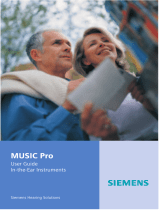 Battery-Biz MUSIC Pro Pro IT User manual
Battery-Biz MUSIC Pro Pro IT User manual
-
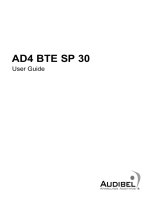 Audibel AD4 BTE SP 30 User guide
Audibel AD4 BTE SP 30 User guide
-
Widex Bravo serie B2 Owner's manual
-
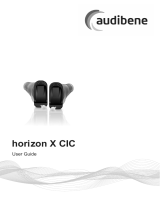 AUDIBENE horizon 3X CIC User guide
AUDIBENE horizon 3X CIC User guide
-
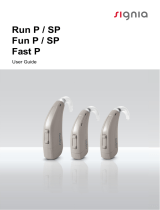 Signia RUN SP User guide
Signia RUN SP User guide
-
ReSound Match SP Behind-the-Ear User guide
-
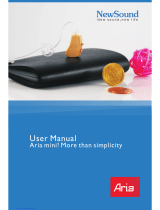 NewSound Aria mini series User manual
NewSound Aria mini series User manual
-
Siemens Pure 700 Owner's manual



























